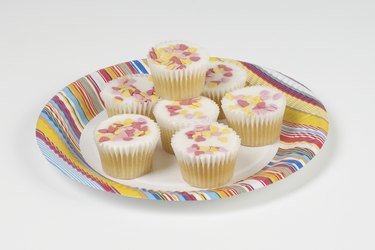
White flour gives a lighter texture to muffins, cakes and cookies and a flakier crust to pies and pastries, but it's not particularly healthy. Also called refined flour, white flour has had many of its nutrients and most of its fiber removed during processing. Although it is often enriched with vitamins and minerals, it is nutritionally inferior to whole-grain flours. Focus your diet on whole foods, such as fruits, vegetables, lean meats and whole grains, and it will be easier to avoid white flour.
The White Flour Problem
Video of the Day
White flour is made by stripping the fiber-rich bran and the nutrient-dense germ from whole grains. This leaves behind only the starchy center of the grain called the endosperm. Without the fiber, white flour is metabolized very quickly into sugar in your bloodstream, which can result in a quick surge of energy and then a crash.
Video of the Day
Whole-Grain Goodness
Whole grains are minimally processed and contain the entire grain, including the germ, bran and endosperm. Your body has to work harder to break down whole grains, which means they digest more slowly to provide long-term energy and satiety. Whole-wheat, brown rice, barley, amaranth, buckwheat, rye, quinoa, oats, wild rice, teff and millet are all examples of whole grains. All of these can be ground into flour and used in much the same way that white flour is used.
Breads and Pastas Without White Flour
It's easy to spot a whole grain when you're buying a package of brown rice or scooping quinoa out of the bulk bin at the supermarket, but finding processed foods, such as breads and pastas, that don't contain white flour calls for a little more sleuthing. Look carefully at the nutrition label. Sometimes white flour will be listed in the ingredients; other times the ingredients list may say "enriched flour" or "wheat flour." These are both types of white flour. Look for whole-grain flour or whole-wheat flour in the ingredients list. Alternatively, look for a label on the package that says "100 percent whole grain." Note that labels which say "made with whole grains" or "multi-grain" mean the product may still contain white flour.
Processed and Frozen Foods
To be sure you're not eating any white flour, stick to whole foods as much as possible. Flour is often used as a thickener in a variety of processed foods such as sauces and gravies and may be present in foods you wouldn't expect. Scan the ingredients list of any product you buy to be sure it doesn't contain white flour. White flour may also be listed as enriched flour, cake flour, all-purpose flour, refined flour, pastry flour and bread flour.
Other Healthy Foods Without White Flour
In addition to whole grains and foods made with whole grains and whole-grain flours, other no-white-flour foods include fruits and vegetables; nuts and seeds; meats, poultry and seafood; some meat alternatives such as tofu; dairy products; dairy alternatives such as almond and soy milk; and fats such as butter and vegetable oils. Plain herbs and spices and beverages such as 100-percent fruit juice and tea are free of white flour.
Sample Meal Plan
On your no-white-flour eating plan, start the day with a healthy breakfast of whole oats cooked with almond milk and topped with fresh berries. At lunch, make a big salad packed with dark, leafy greens and other veggies and top it with cubes of grilled chicken breast or chickpeas and almonds. At dinner, sit down to a plate of baked salmon, brown rice and steamed broccoli. Snack on cut veggies or 100-percent whole-grain crackers and hummus if you get hungry between meals.